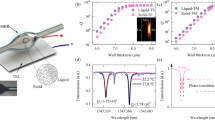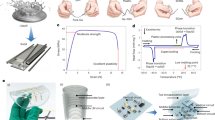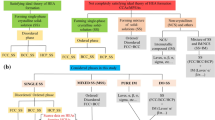Abstract
Kinetically trapping the high-temperature states through rapid cooling solidification is widely used for the synthesis of high-entropy alloys (HEAs), especially those with intrinsically immiscible elemental combinations1,2,3,4. However, strategies need to be developed to overcome the fundamental limitations of rapid cooling solidification in controlling the crystallinity, structure and morphology of HEAs. Here we introduce an isothermal solidification strategy for the synthesis of HEAs by rapidly altering the metal alloy composition through liquid–liquid interface reactions at low temperatures, for example, from 25 °C to 80 °C. We use gallium (Ga)-based metal as the sacrificial reagent and mixing medium. By directing the reactions to the interfaces between the Ga-based liquid metal and an aqueous metal ion solution, the foreign metal ions can be reduced at the interfaces and incorporated into the liquid metal quickly. HEAs with various crystallinity (single crystal, mesocrystal, polycrystal and amorphous), morphology (zero, two and three dimensions) and compositions can be achieved through the isothermal solidification. Ga can be completely consumed, resulting in Ga-free HEAs. If desired, Ga can be one of the metal elements in the final products. In situ liquid phase transmission electron microscopy (TEM) studies and theoretical analysis show the isothermal solidification mechanisms. Our direct observations show the enhanced mixing of liquid metal elements and the solidification process with fluctuating nucleation dynamics. The isothermal solidification marks a powerful strategy for HEA synthesis through an unexplored pathway of kinetically trapping the high-entropy states.
This is a preview of subscription content, access via your institution
Access options
Access Nature and 54 other Nature Portfolio journals
Get Nature+, our best-value online-access subscription
$32.99 / 30 days
cancel any time
Subscribe to this journal
Receive 51 print issues and online access
$199.00 per year
only $3.90 per issue
Buy this article
- Purchase on SpringerLink
- Instant access to full article PDF
Prices may be subject to local taxes which are calculated during checkout





Similar content being viewed by others
Data availability
All data generated or analysed during this study are available in the paper and its Supplementary Information.
References
Yao, Y. et al. Carbothermal shock synthesis of high-entropy-alloy nanoparticles. Science 359, 1489–1494 (2018).
Li, M. et al. High-entropy alloy electrocatalysts go to (sub-) nanoscale. Sci. Adv. 10, eadn2877 (2024).
Gao, S. et al. Synthesis of high-entropy alloy nanoparticles on supports by the fast moving bed pyrolysis. Nat. Commun. 11, 2016 (2020).
Wang, B. et al. General synthesis of high-entropy alloy and ceramic nanoparticles in nanoseconds. Nat. Synth. 1, 138–146 (2022).
Chen, P.-C. et al. Polyelemental nanoparticle libraries. Science 352, 1565–1569 (2016).
Sun, Y. & Dai, S. High-entropy materials for catalysis: a new frontier. Sci. Adv. 7, eabg1600 (2021).
Yao, Y. et al. High-entropy nanoparticles: synthesis-structure-property relationships and data-driven discovery. Science 376, eabn3103 (2022).
Xin, Y. et al. High-entropy alloys as a platform for catalysis: progress, challenges, and opportunities. ACS Catal. 10, 11280–11306 (2020).
Liu, Y.-H. et al. Toward controllable and predictable synthesis of high-entropy alloy nanocrystals. Sci. Adv. 9, eadf9931 (2023).
Ouyang, B. & Zeng, Y. The rise of high-entropy battery materials. Nat. Commun. 15, 973 (2024).
Liu, D. et al. Exceptional fracture toughness of CrCoNi-based medium-and high-entropy alloys at 20 kelvin. Science 378, 978–983 (2022).
Cao, G. et al. Liquid metal for high-entropy alloy nanoparticles synthesis. Nature 619, 73–77 (2023).
Kang, Y. et al. Mesoporous multimetallic nanospheres with exposed highly entropic alloy sites. Nat. Commun. 14, 4182 (2023).
Zhan, C. et al. Subnanometer high-entropy alloy nanowires enable remarkable hydrogen oxidation catalysis. Nat. Commun. 12, 6261 (2021).
Li, Y. et al. Cu-based high-entropy two-dimensional oxide as stable and active photothermal catalyst. Nat. Commun. 14, 3171 (2023).
Zavabeti, A. et al. A liquid metal reaction environment for the room-temperature synthesis of atomically thin metal oxides. Science 358, 332–335 (2017).
Idrus-Saidi, S. A. et al. Liquid metal synthesis solvents for metallic crystals. Science 378, 1118–1124 (2022).
Taccardi, N. et al. Gallium-rich Pd–Ga phases as supported liquid metal catalysts. Nat. Chem. 9, 862–867 (2017).
Hong, S.-J. & Suryanarayana, C. Mechanism of low-temperature θ-CuGa2 phase formation in Cu-Ga alloys by mechanical alloying. J. Appl. Phys. 96, 6120–6126 (2004).
Brandes, E. A. & Brook, G. Smithells Metals Reference Book (Elsevier, 2013).
Dean, J. A. Lange’s Handbook of Chemistry (McGraw-Hill, Inc., 1999).
Yao, Y. et al. Computationally aided, entropy-driven synthesis of highly efficient and durable multi-elemental alloy catalysts. Sci. Adv. 6, eaaz0510 (2020).
Chang, X., Zeng, M., Liu, K. & Fu, L. Phase engineering of high‐entropy alloys. Adv. Mater. 32, 1907226 (2020).
Young, D. A. Phase Diagrams of the Elements (Univ. California Press, 2023).
Gan, T., Handschuh-Wang, S., Shang, W. & Zhou, X. GaOOH crystallite growth on liquid metal microdroplets in water: influence of the local environment. Langmuir 38, 14475–14484 (2022).
Turnbull, D. Kinetics of solidification of supercooled liquid mercury droplets. J. Chem. Phys. 20, 411–424 (1952).
Kalikmanov, V. I. Nucleation Theory (Springer, 2013).
Takeuchi, A. & Inoue, A. Classification of bulk metallic glasses by atomic size difference, heat of mixing and period of constituent elements and its application to characterization of the main alloying element. Mater. Trans. 46, 2817–2829 (2005).
Tandoc, C., Hu, Y.-J., Qi, L. & Liaw, P. K. Mining of lattice distortion, strength, and intrinsic ductility of refractory high entropy alloys. npj Comput. Mater. 9, 53 (2023).
Khalajzadeh, V. & Beckermann, C. Simulation of shrinkage porosity formation during alloy solidification. Metall. Mater. Trans. A 51, 2239–2254 (2020).
Gránásy, L., Pusztai, T., Börzsönyi, T., Warren, J. A. & Douglas, J. F. A general mechanism of polycrystalline growth. Nat. Mater. 3, 645–650 (2004).
Yamaguchi, A., Mashima, Y. & Iyoda, T. Reversible size control of liquid‐metal nanoparticles under ultrasonication. Angew. Chem. Int. Ed. 54, 12809–12813 (2015).
Yu, Q. et al. Identifying surface structural changes in a newly-developed Ga-based alloy with melting temperature below 10 °C. Appl. Surf. Sci. 492, 143–149 (2019).
Acknowledgements
This work was supported by the US Department of Energy, Office of Science, Office of Basic Energy Sciences (BES), Materials Sciences and Engineering Division under contract no. DE-AC02-05-CH11231 within the in situ TEM program (KC22ZH) and under contract no. DE-AC02-05-CH11231 within the D2S2 program (KCD2S2). Work at the Molecular Foundry of Lawrence Berkeley National Laboratory (LBNL) was supported by the US Department of Energy under contract no. DE-AC02-05CH11231. Y.H. acknowledges support from the National Science Foundation under award 2404462.
Author information
Authors and Affiliations
Contributions
Q. Zhang and H.Z. conceived this work. Q. Zhang designed and performed the in situ TEM experiments. Q. Zhang and Y.C. performed the ex situ experiment on HEA synthesis and HEA characterization. Y.L. performed electrocatalytic tests under the supervision of Y.H.; L.C. performed the XPS characterization and analysed the XPS data; M.C.G. discussed the thermodynamic and kinetic theory for the synthesis method under the supervision of K.A.P.; Q. Zhang, Z.S., Y.C., Q. Zheng, K.C.B., L.C. and H.Z. carried out data analysis. Q. Zhang and H.Z. co-wrote the paper with input from all authors. This work was done under the supervision of H.Z.
Corresponding author
Ethics declarations
Competing interests
The authors declare no competing interests.
Peer review
Peer review information
Nature thanks Yusuke Yamauchi and the other, anonymous, reviewer(s) for their contribution to the peer review of this work.
Additional information
Publisher’s note Springer Nature remains neutral with regard to jurisdictional claims in published maps and institutional affiliations.
Extended data figures and tables
Extended Data Fig. 1 TEM characterization of Ga nanoparticles.
a, A low-magnification STEM image reveals the size characteristics of Ga nanoparticles. b, The HRTEM image, along with the corresponding FFT pattern of the Ga nanoparticle, indicates its amorphous structure. c, A STEM-EDS spectrum of a Ga nanoparticle confirms the presence of Ga and O elements, with Cu signals originating from the supporting Cu grid. d, STEM-EDS mapping of a Ga nanoparticle: HAADF image, Ga-Kα map, O map, and Ga-Kα&O map. The presence of O exclusively distributed on the shell part demonstrates the existence of an oxide shell.
Extended Data Fig. 2 EDS characterization of a GISZ nanoparticle.
a, STEM-EDS mapping of a GISZ nanoparticle including HAADF image, Ga-Kα map, In-Lα map, Sn-Lβ map, Zn-Kα map, and O map. The presence of O exclusively distributed on the shell part demonstrates the existence of an oxide shell. b, The STEM-EDS spectrum of a GISZ nanoparticle confirms the presence of Ga, In, Sn, Zn, and O elements, with Cu signals attributed to the underlying Cu grid.
Extended Data Fig. 3 TEM characterization of HEA with phase separation.
STEM-EDS mapping of the heterostructured HEA-NP includes HAADF imaging along with elemental maps: Ga-L, Cu-Kα, Pd-L, Pt-Lβ, Au-L, Pb-Lβ, and a combined Ga-L & Pd-L map. The EDS mapping reveals a non-uniform elemental distribution within the nanoparticles, with the Ga-L & Pd-L maps highlighting the distinct phase segregation.
Extended Data Fig. 4 TEM characterization of a mesocrystal HEA-NPs (corresponding to Fig. 4c).
a, A low-magnification TEM image reveals a large, porous spherical particle composed of numerous smaller nanoclusters. b, An enlarged view of the mesocrystal structure. c, pseudo-color image of (b). d, The corresponding FFT pattern demonstrates that the crystalline domains are not perfectly aligned, indicating the lattice distortion.
Extended Data Fig. 5 Characterization of mesocrystal HEA nanosheets.
a, A low-magnification STEM image highlights the two-dimensional morphology of the high-entropy nanosheets. b, The HRTEM image reveals their mesocrystal structure, with individual single crystalline domains exhibiting parallel crystallographic alignment while remaining spatially separated. c, An inverse fast Fourier transform (IFFT) image of the HRTEM emphasizes the distinct, separated crystal domains. d, The corresponding FFT pattern indicates that the crystalline domains are not perfectly aligned, showing signs of rotational misalignment. e, STEM-EDS maps demonstrate that the elements are uniformly distributed throughout the nanosheets.
Extended Data Fig. 6 EDS characterization of the HEA-NPs using Galinstan precursor at 40 °C.
a, STEM-EDS mapping of the HEA-NPs: HAADF image, Ga-Kα map, Cu-Kβ map, Ni-Kα map, In-Lα map, Pt-Lβ map, Au-Lα map, Pd-L map, Sn-Lβ map, and Cl-K map. The EDS mapping reveals uniform elemental distribution within the nanoparticle. Cl does not belong to the HEA composition. b, The EDS spectrum of the HEA reveals the presence of C, O, Ga, Cu, Ni, In, Pt, Au, Pd, and Cl elements. C, O, and Cl originate from the carbon supporting film and residual salts.
Extended Data Fig. 7 Structural analysis of hierarchical HEA nanomaterials.
a, TEM image of the basic flower structure. b, HRTEM showing the amorphous structure. c, the corresponding FFT (b). d, STEM-EDS maps of the three-dimensional hierarchical nanostructures show the elemental distribution.
Extended Data Fig. 8 TEM characterization of HEA with 20 elements (corresponding to Fig. 5a).
a, HRTEM image reveals the crystal structure of the HEA-NPs. b, The corresponding FFT pattern reveals its mesocrystal structure.
Extended Data Fig. 9 Configurational analysis of selected three-dimensional hierarchical HEAs.
a-c, STEM images of the three-dimensional HEA structure with “grape bunches” morphology. a, Flower structure of the basic building block. b, The flower structures are aligned to form a chain. Yellow dashed lines highlight the chain structure. c, Chain-like structures aggregate to form large grape-bunch-like assemblies. d, The three-dimensional HEA structure in the shape of feathers. e, The three-dimensional HEA structure with “plum blossoms” morphology.
Extended Data Fig. 10 Morphology diagram of HEA nanomaterials.
STEM images show the diverse morphology of HEAs. a, To synthesize nanoparticles in panel (a), we utilize sphere liquid Ga (marked with red outline) or liquid Ga alloy (marked with yellow outline) as precursors. Additionally, we introduce HCl into the metal salt solution to eliminate the surface oxide of the Ga and Ga alloy particles. The reaction temperature with the red outline is 30 °C and the reaction temperature with yellow outline is room temperature. b, d, f, The synthesis conditions for the particles depicted in panel (b), (d), and (f) mirror those in panel (a), but with elevated reaction temperatures of 40 °C, 60 °C, and 80 °C. c, We employ spherical shape (marked with indigo outline), irregular shape (marked with green outline), and two-dimensional-film (marked with white outline) liquid Ga/Ga alloy precursors, without the addition of HCl in the metal salt solution, and the reaction temperature is 60 °C. e, For HEA synthesis, we use two-dimensional films of liquid Ga/Ga alloy precursors and the reaction temperature is 80 °C.
Supplementary information
Supplementary Information
This file includes Supplementary Text, Supplementary Figs. 1–38, Supplementary Tables 1–7 and Supplementary References 34–43.
Supplementary Video 1
The dynamic alloying and isothermal solidification processes of nanoparticles during in situ liquid-phase heating TEM experiments. Temperature: 60 °C; liquid environment.
Supplementary Video 2
The dynamic of hydrogen gas drives the rapid movement of liquid metal during the in situ mixing process. Temperature: 60 °C; liquid environment.
Supplementary Video 3
The oscillatory isothermal solidification dynamics of the high-entropy alloy occur during the fusion and consumption of liquid metal domains. Temperature: 60 °C; liquid environment.
Rights and permissions
Springer Nature or its licensor (e.g. a society or other partner) holds exclusive rights to this article under a publishing agreement with the author(s) or other rightsholder(s); author self-archiving of the accepted manuscript version of this article is solely governed by the terms of such publishing agreement and applicable law.
About this article
Cite this article
Zhang, Q., Gallant, M.C., Chen, Y. et al. Isothermal solidification for high-entropy alloy synthesis. Nature 646, 323–330 (2025). https://doi.org/10.1038/s41586-025-09530-w
Received:
Accepted:
Published:
Issue date:
DOI: https://doi.org/10.1038/s41586-025-09530-w



